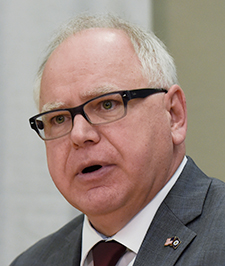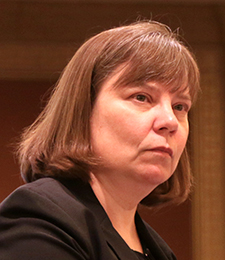The state’s top budget and finance officer called it “out of the ordinary.”
Gov. Tim Walz said it proved that “it is crystal clear that our economy is strong and growing.”
Senate Finance Committee Chair Julie Rosen called it “staggering.”
While Minnesota’s record $7.7 billion budget surplus announced last week is all of that and more, it also raises a question: is it unique? Did Minnesota see the benefits of doing anything other states didn’t?
Probably not.
“I think the federal government essentially made it impossible, fiscally impossible, not to survive,” said Mark Haveman, executive director of the Minnesota Center for Fiscal Excellence, a business-leaning nonprofit that analyzes state spending and taxation, referring to the three different interventions by Congress that sent billions of dollars into the state economy via extended unemployment, business grants, stimulus checks, money for hospitals and transit and child care.
Haveman said the statistic that “absolutely blows my mind” is that states’ personal income growth in 2020 — the heart of the pandemic — was the highest in 20 years, “thanks to government transfers.”
“That’s what was lurking behind the scenes here,” he said. “That stat puts in crystal clear perspective how critical the federal government was in this whole process and why everybody is largely doing OK.”
“Strong tax-revenue growth over the past year has been almost universal across states, and Minnesota was no exception,” said Justin Theal, an officer with the state fiscal health team at Pew Charitable Trusts.
Many states can point to similar numbers
State Commissioner of Minnesota Management and Budget Jim Schowalter noted that the state economy is doing well despite a lingering pandemic. “As our hospitals remind us, COVID-19 is still here, it is still dangerous,” Schowalter said. “However, our economy is learning how to adapt.”

The surplus is so large that lawmakers will consider both tax cuts and spending increases after the Legislature convenes on Jan. 31 — and could end up with some of both. The $52 billion two-year budget adopted earlier this year was already considered to be the most generous in decades, thanks to robust tax collections and billions in federal cash.
Yet governors in most states whether their pandemic interventions were aggressive, lax or (like Minnesota) somewhere in the middle can point to similar economic numbers. And other state legislatures are now also deciding what to do with large surpluses. Both tax cuts and spending on areas such as education and health care are being considered everywhere from California (with a $31 billion surplus) to Iowa ($1.4 billion).
Those surpluses come after states have refilled and added money to their rainy day savings accounts, often set up to be spent only when tax collections fall precipitously in recessions. “After a one-year dip, states’ combined fiscal cushion … was expected to spring back and exceed pre-pandemic highs by the state of the budget year,” the Pew state fiscal health project reported in October.
Minnesota didn’t dip into its then-$2.4 billion reserves but Walz said having it gave budget managers time to weather the early months and not make budget cuts that could have done their own damage to the economy. Knowing it had a cushion, the state benefited without even having to spend it.
Theal, from Pew, said states had predicted multi-year revenue losses as the pandemic was starting to spread. But declines in tax collections were limited to a single quarter of 2020 before revenues began to increase again in the summer of that year. “Collections haven’t just returned to their pre-pandemic levels but outpaced pre-pandemic trends in each quarter of states’ most-recent budget years,” he said. “They’ve taken in more money over the last four quarters than they would have without the pandemic at all.”
Minnesota is one of 47 states that posted year-over-year gains and is one of 45 states to have returned to their pre-pandemic levels by the end of the second quarter of 2021, he said.
Federal spending was key
The federal spending has helped states on both the spending and revenue sides of the ledger. First, the grants covered costs that states might have otherwise borne, such as for Medicaid coverage, public health interventions and business help. Then the billions in cash sent to residents and businesses found their way into tax collections through income and sales taxes.
“The pandemic and recession have added to state spending pressures across the board,” Theal said. “But the availability of federal aid like [American Rescue Plan] funds has largely offset this budgetary risk in the short term.”
He warned, however, that much of that aid will expire, and any impacts on tax collections from federal money given to individuals will have played out by now. In addition, the spending caused by pent-up consumer demand will also be exhausted.
Still, Theal said Minnesota does stand out in how its revenue growth trends are continuing upward according to the bond-rating agency Moody’s, while many other states are projected to be flat. That helped MMB Tuesday to project that the state will remain in surplus for the next four years. Requiring out-years to be in balance is another way Minnesota keeps a check on unsustainable budgets.

“Receipts have not fallen as much as you would have expected given the severity of the increase in the unemployment rate we were seeing in the spring,” Kalambokidis said in the fall of 2020. “Consumer spending has been stronger than what we expected.”
And all states benefited from the federal stimulus spending that enabled residents to continue to spend and helped some businesses keep workers on the payroll.
Tuesday, Kalambokidis said the benefits from all that crossed state lines. “The extraordinary revenue growth that we saw in fiscal year 2021 and the improved forecasts for years ’22 and ’23, that’s consistent with what we are seeing in other states,” she said. “It’s a consistent story all around.”
She did assert, however, that the state’s balanced tax system, with progressive income taxes, corporate taxes and sales taxes, “allowed us to capture tax receipts from the extraordinary growth that we’ve seen.”
Haveman said he couldn’t see much difference between the current financial position of states based on tax structure. For example, both Utah, with a flat income tax, and California, with a highly progressive income tax, survived the pandemic recession handily.
And had the 2020 recession mimicked the 2008 Great Recession, when high earners were hit harder by stock market declines, it might not have fared as well as it did. The dominant factor this time around was federal spending. States vary so much on their mix of taxes and economies that teasing out any individual factors and whether a state’s own actions made a difference is difficult, Haveman said.
One policy choice made by Minnesota that did help is the existence and the structure of its rainy day fund, he said, noting that Walz’s statement that it gave the state time to react to the pandemic deliberately is “spot on.”
“Not only is it good to have it, you need to have it with our progressive income tax,” which taxes higher incomes at a higher rate than lower incomes and can create volatility in collections in economic downturns, he said. “Technically as well as structurally and politically, it’s a very good thing that the people of Minnesota should be quite proud of.”


0 Commentaires